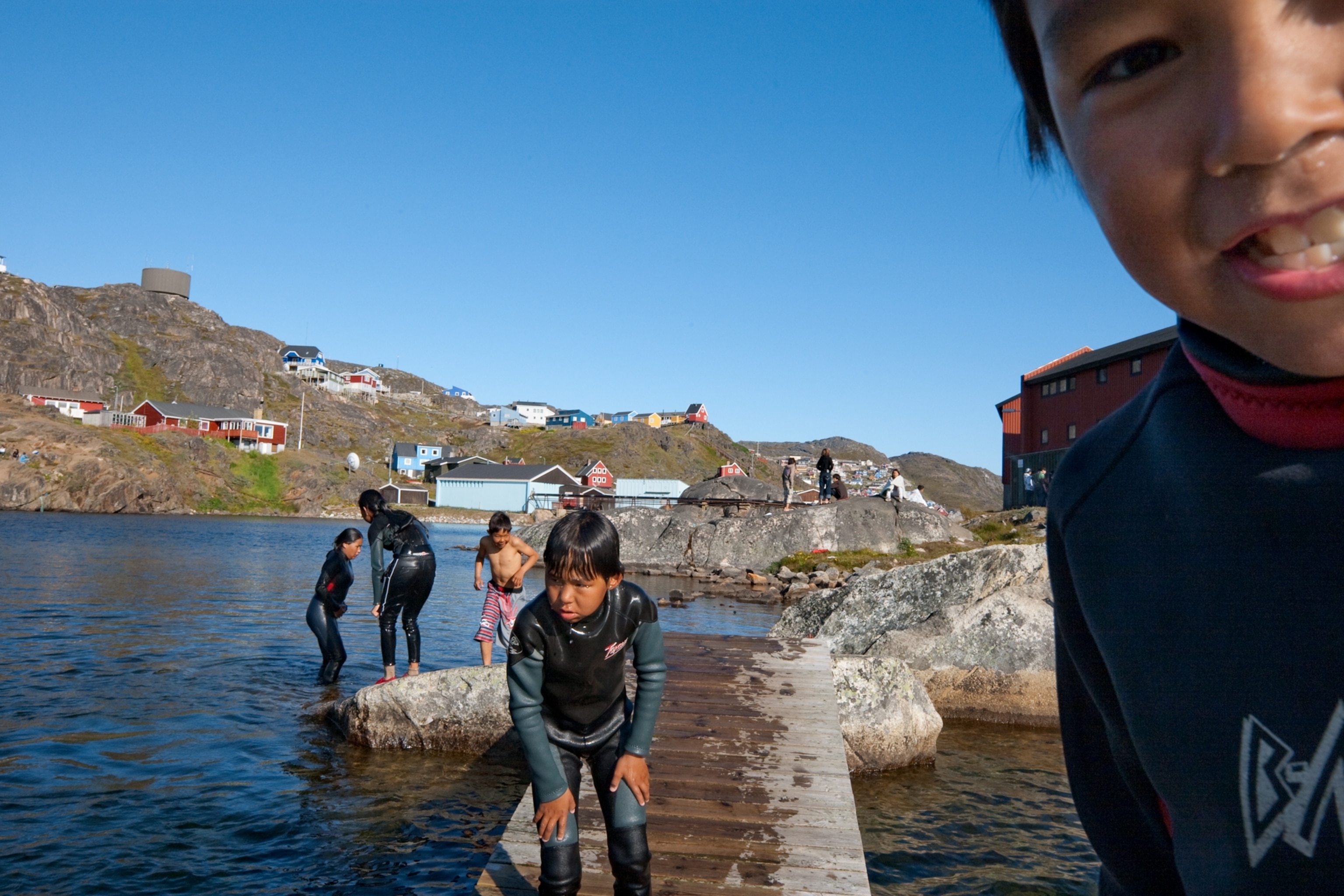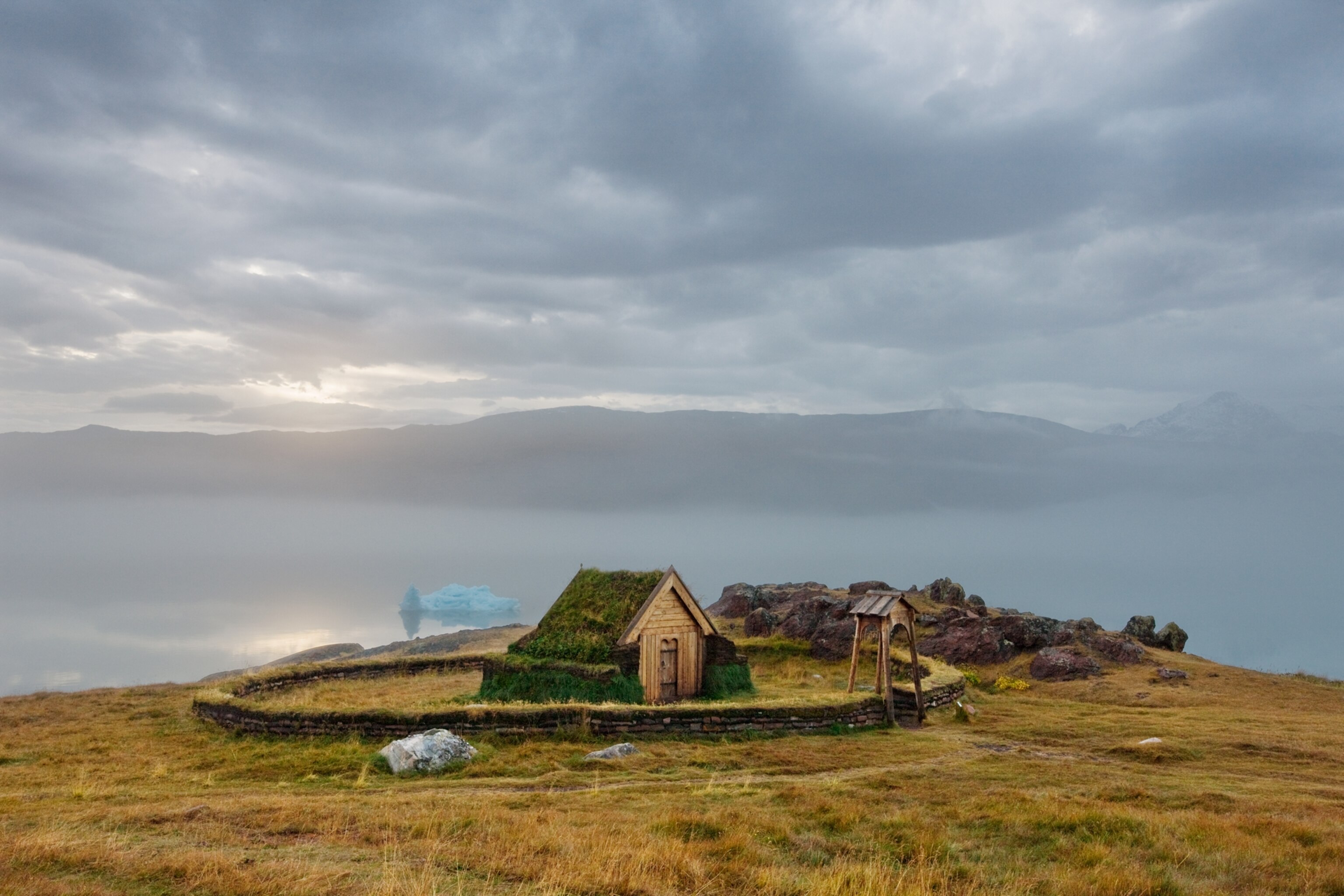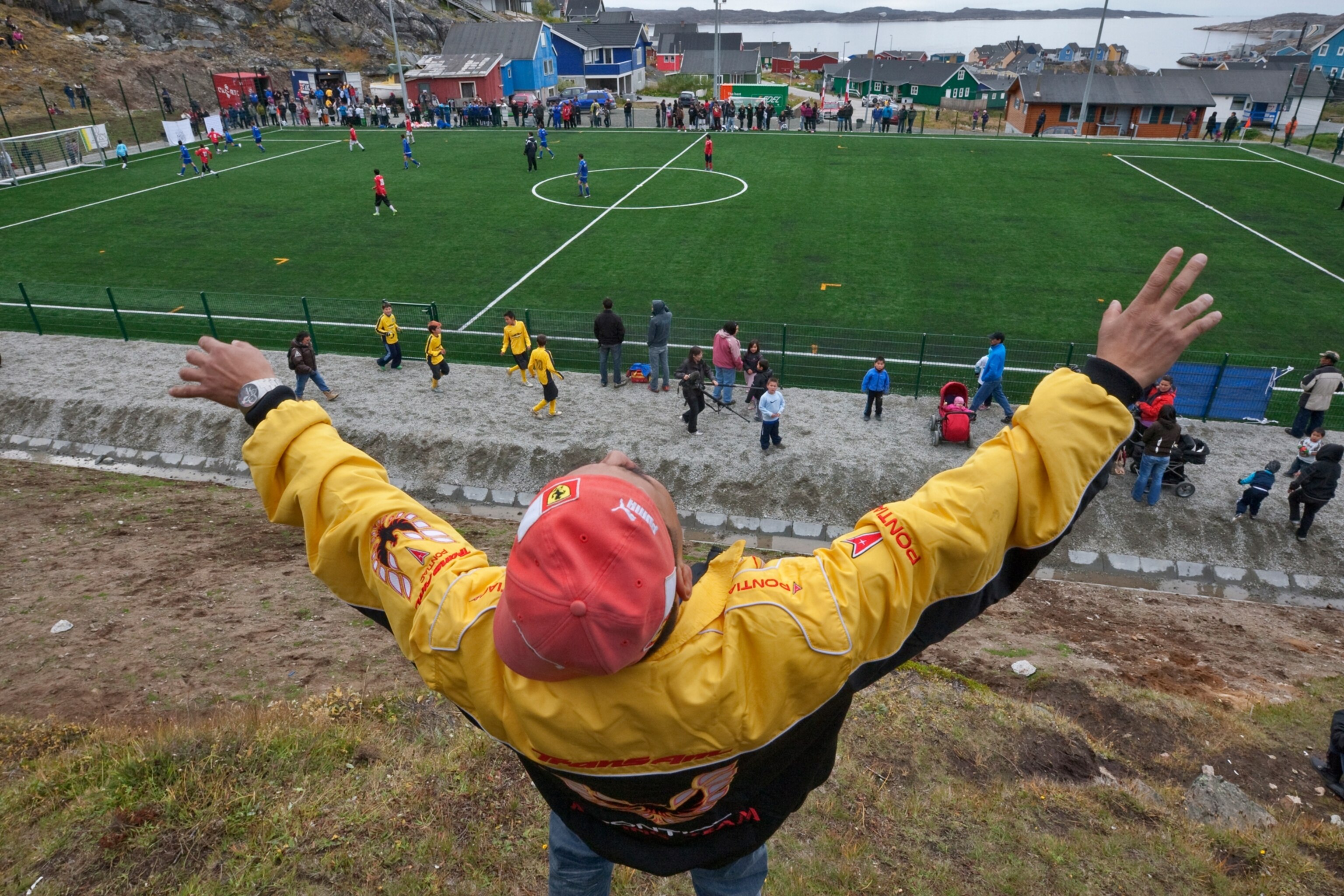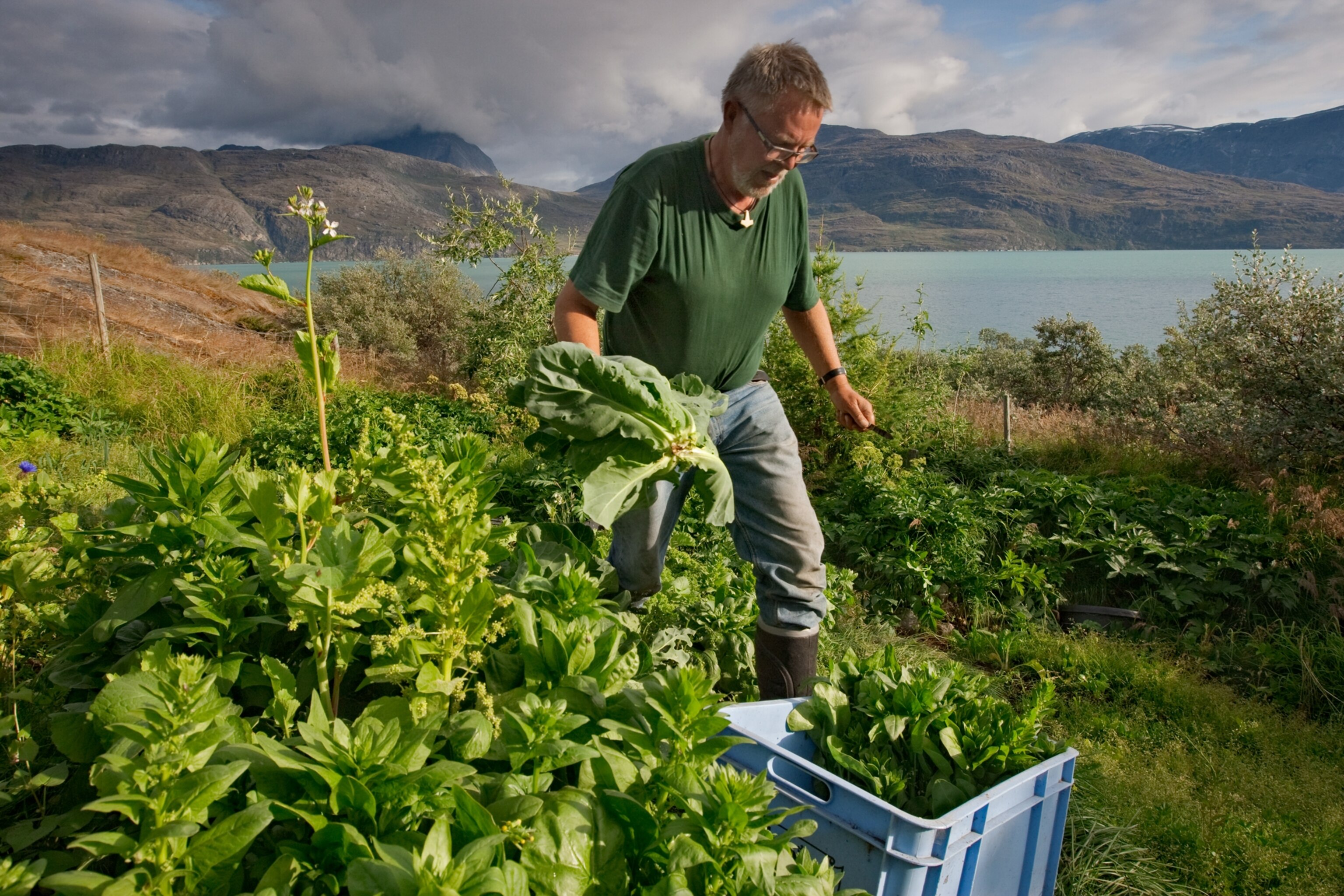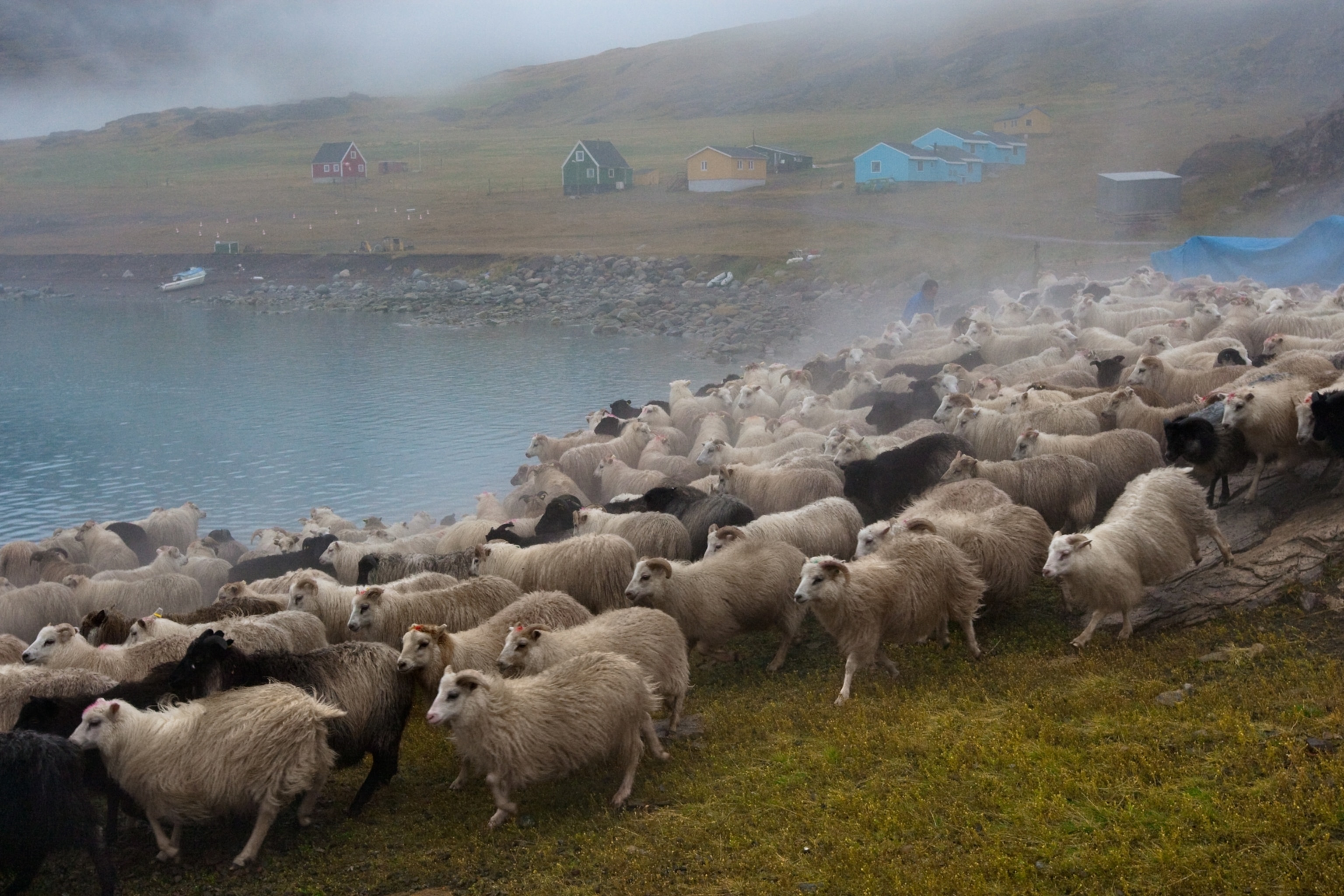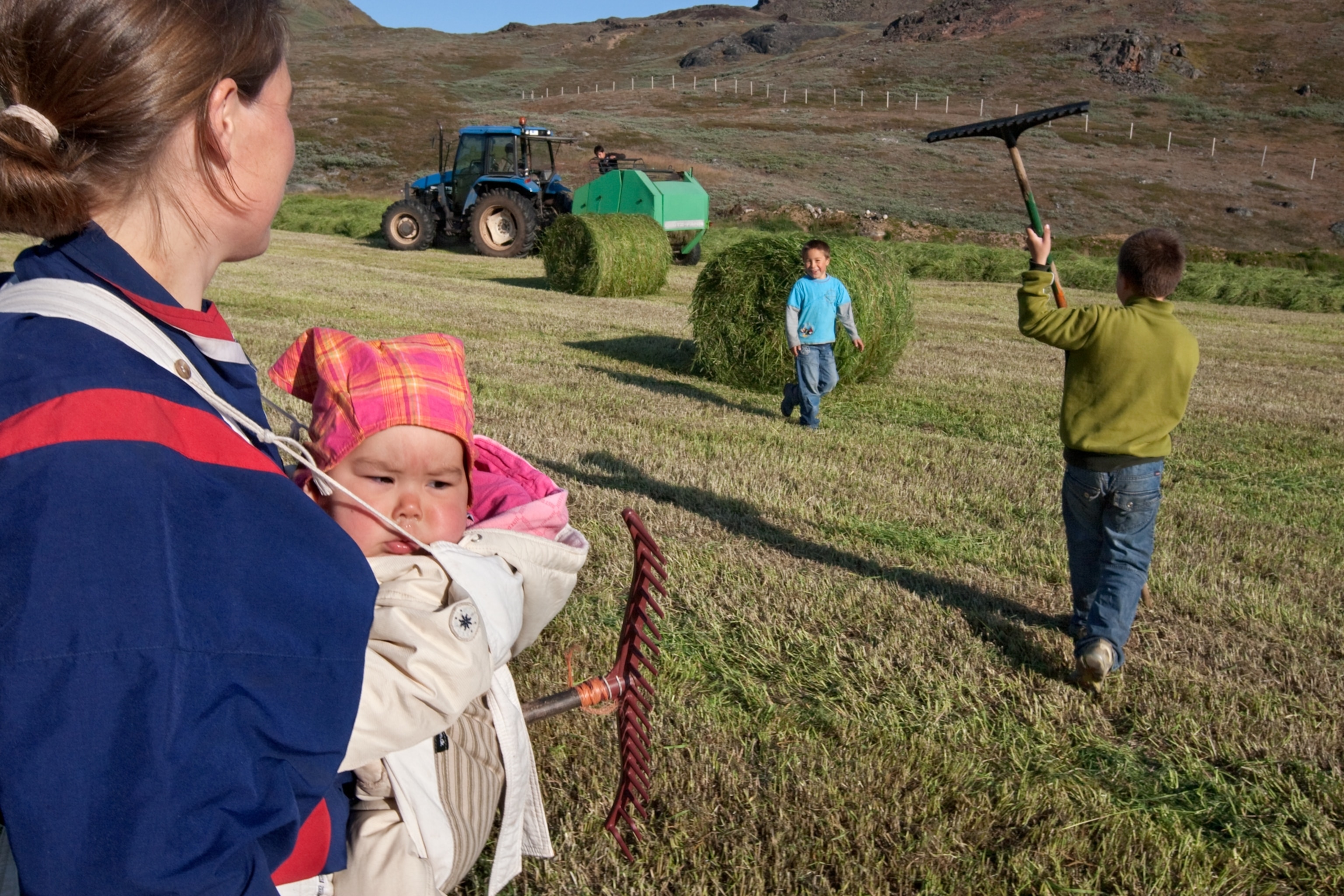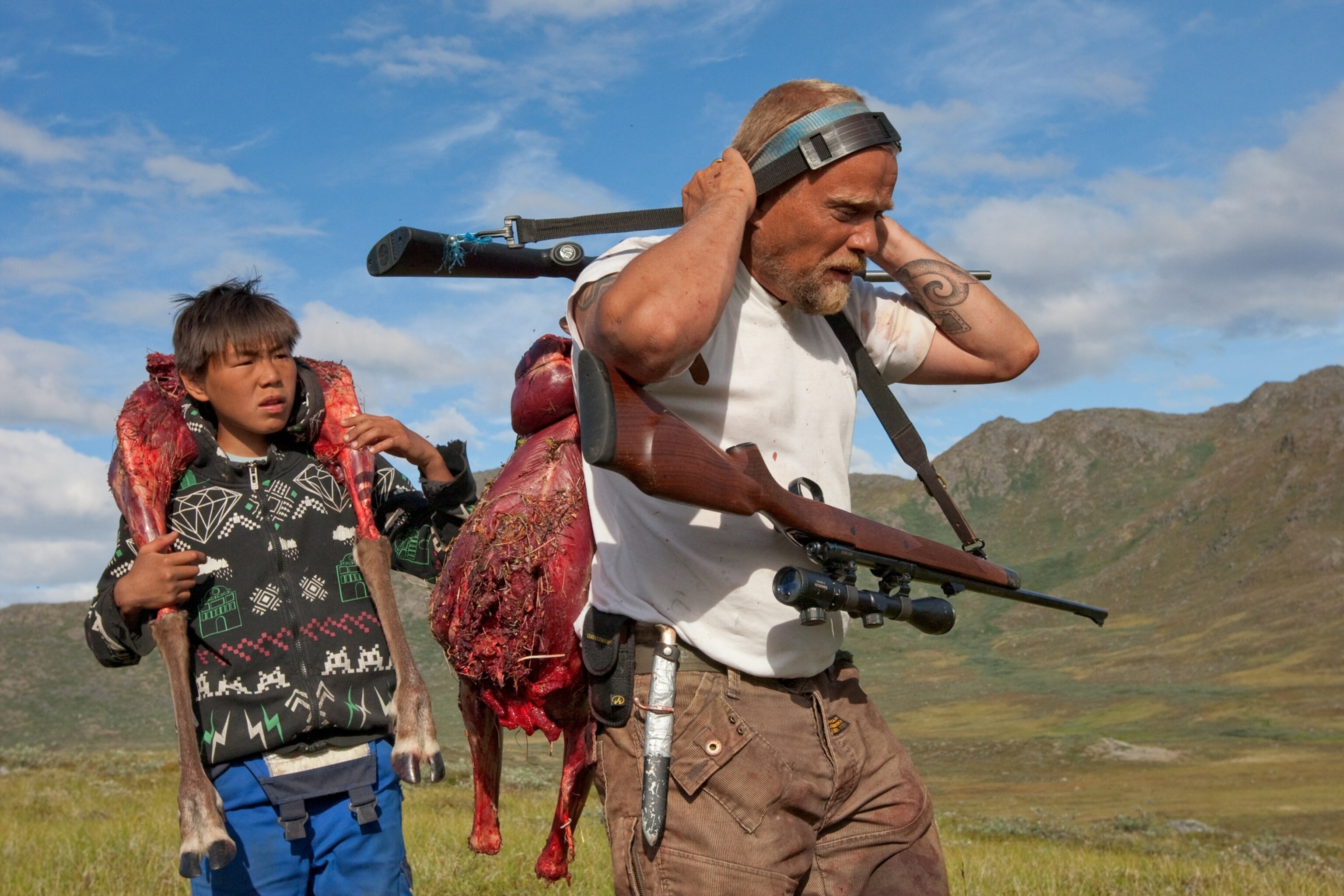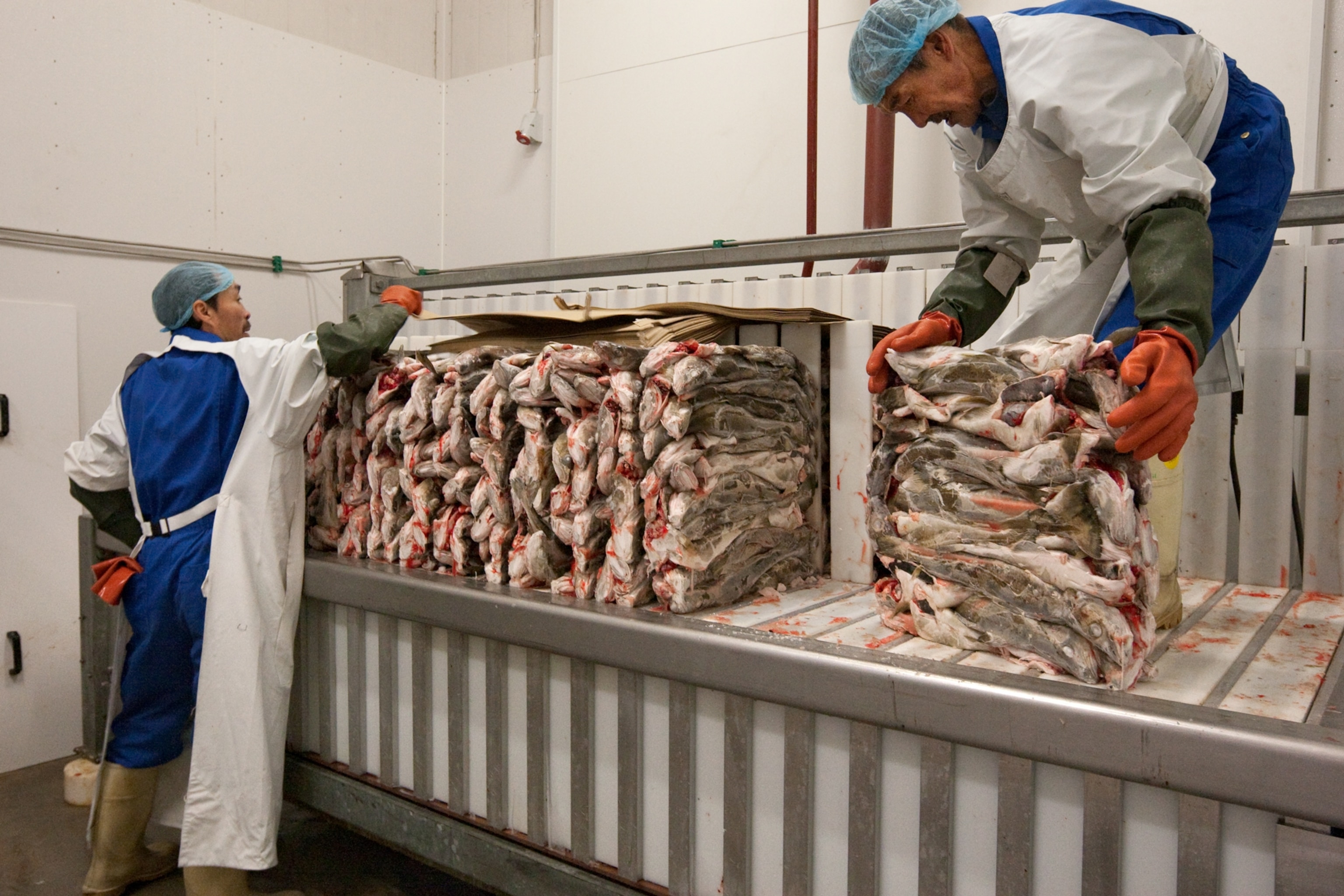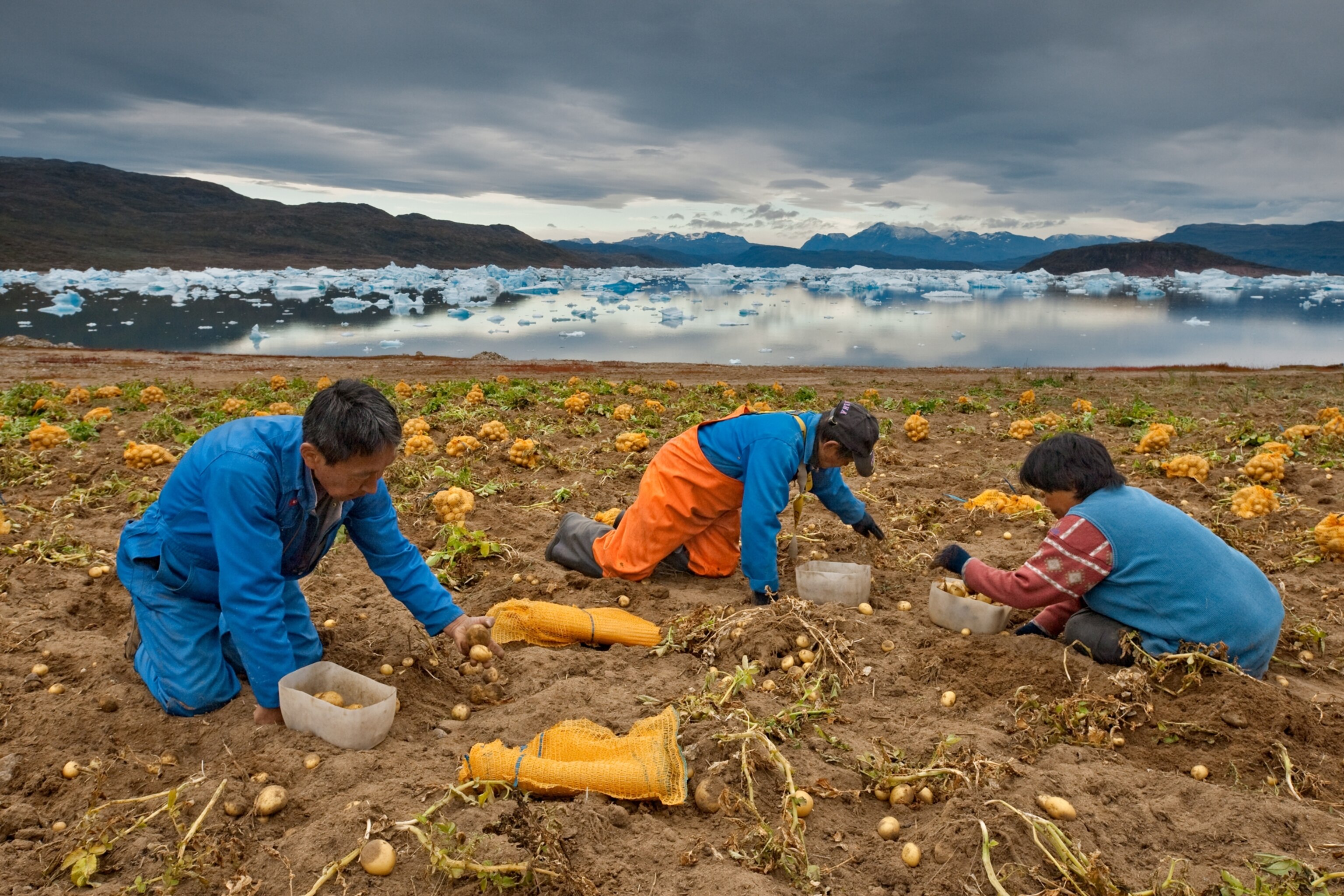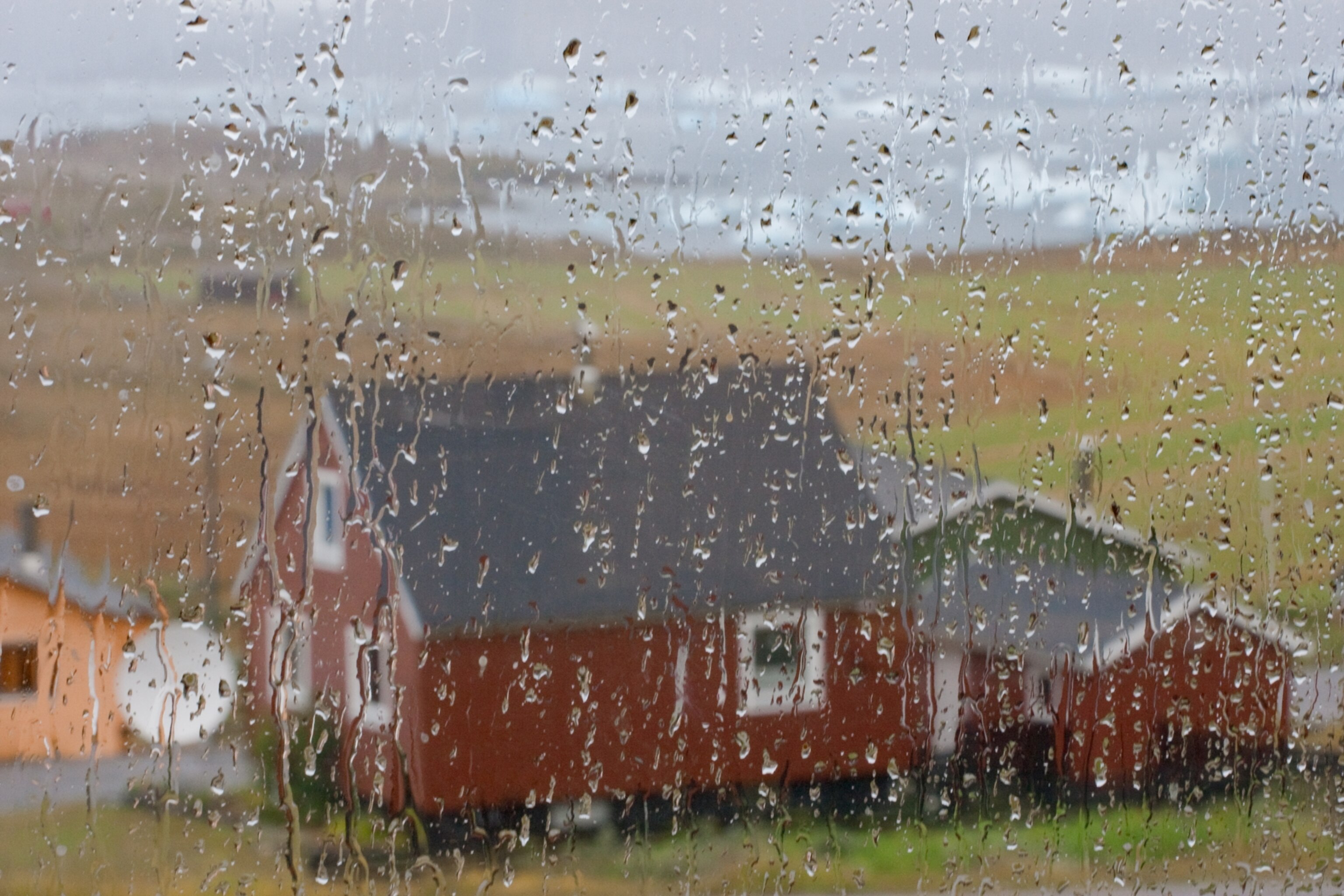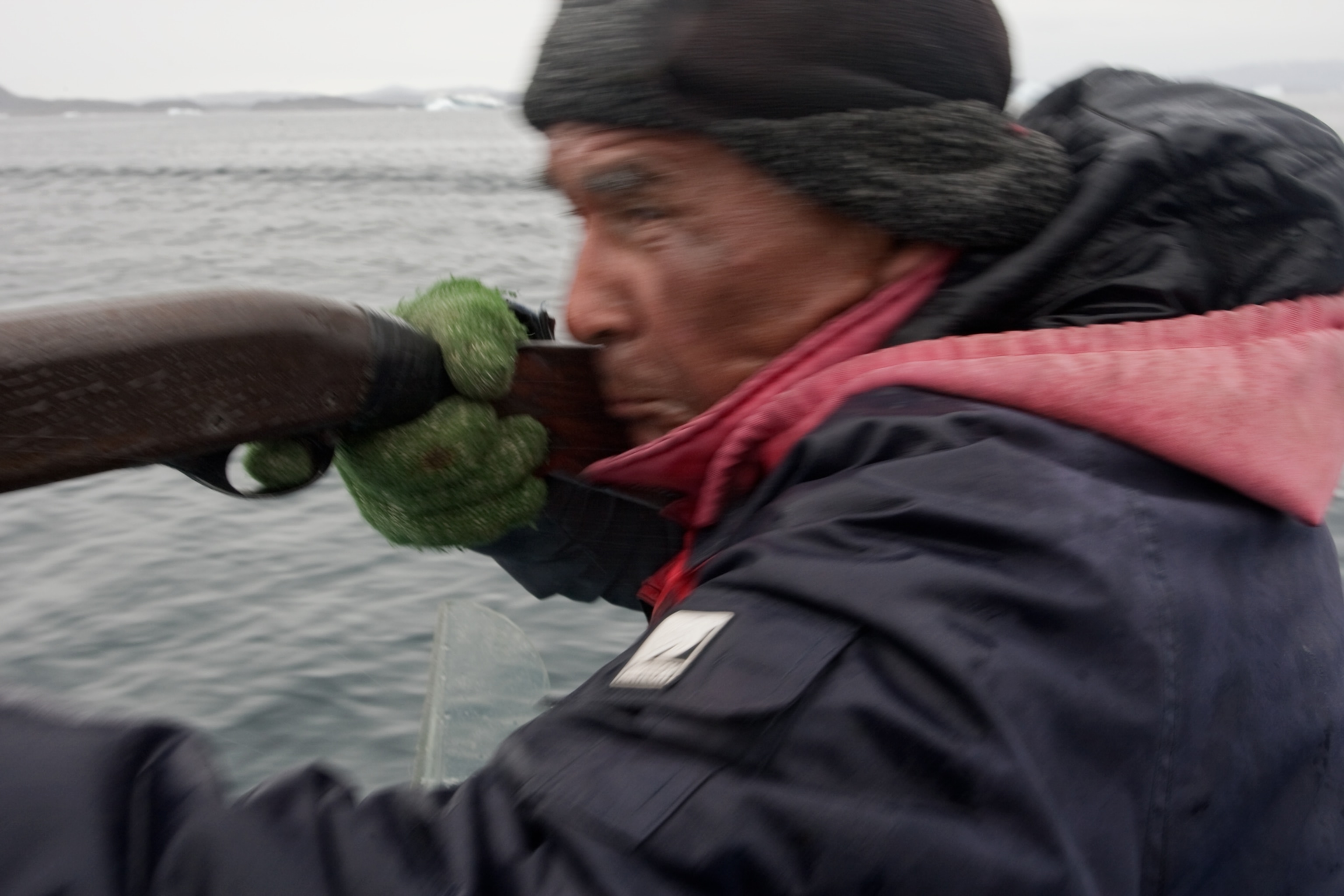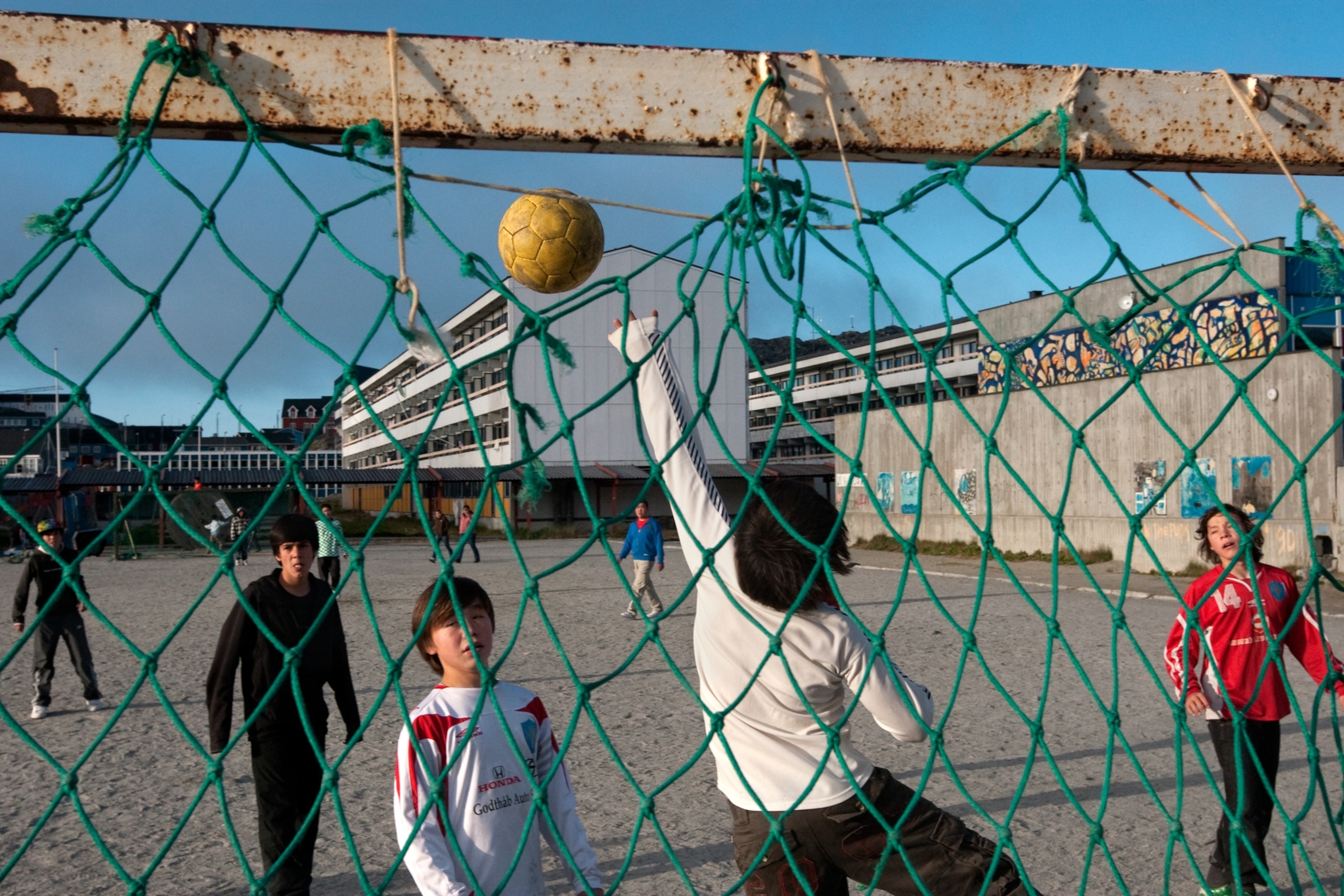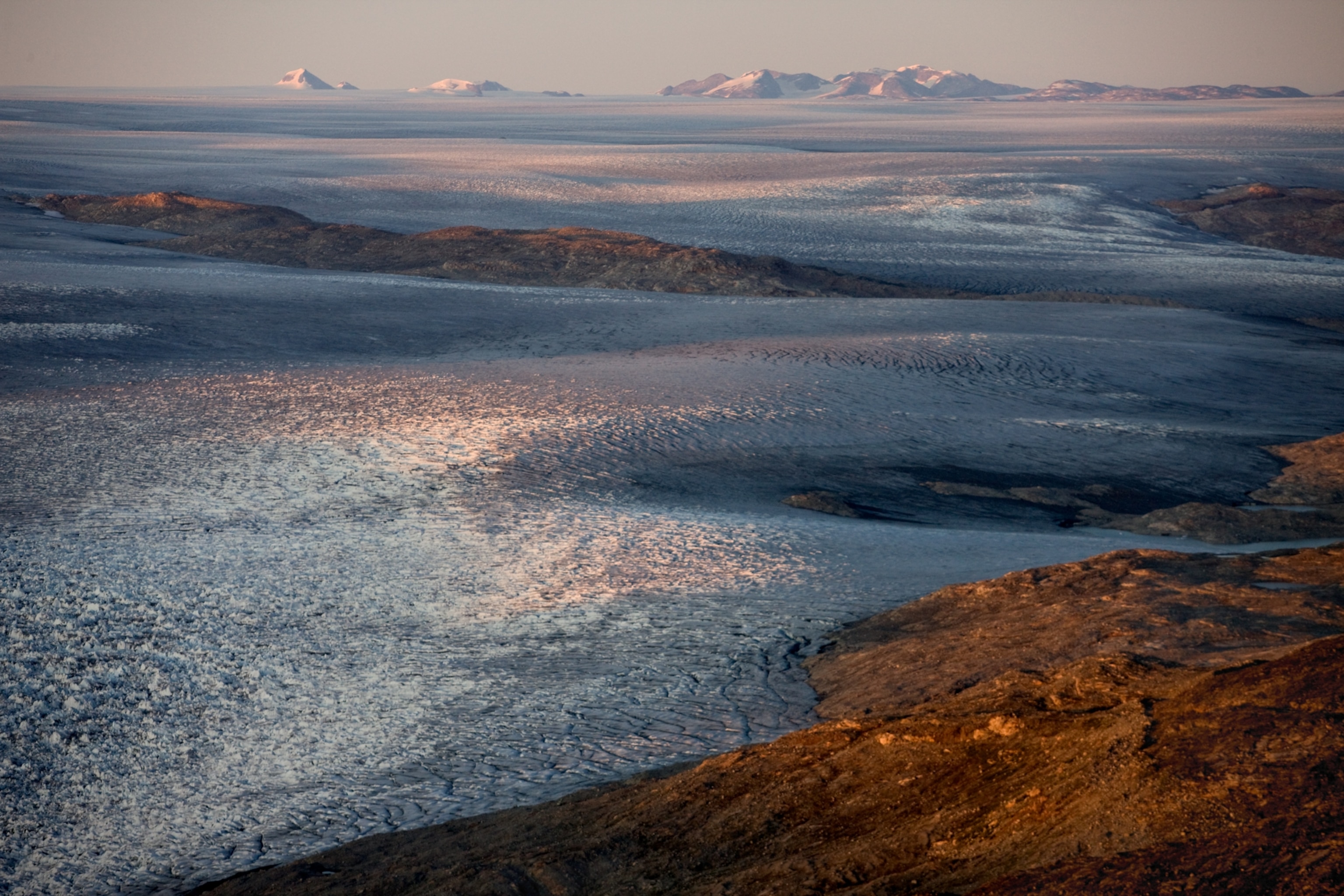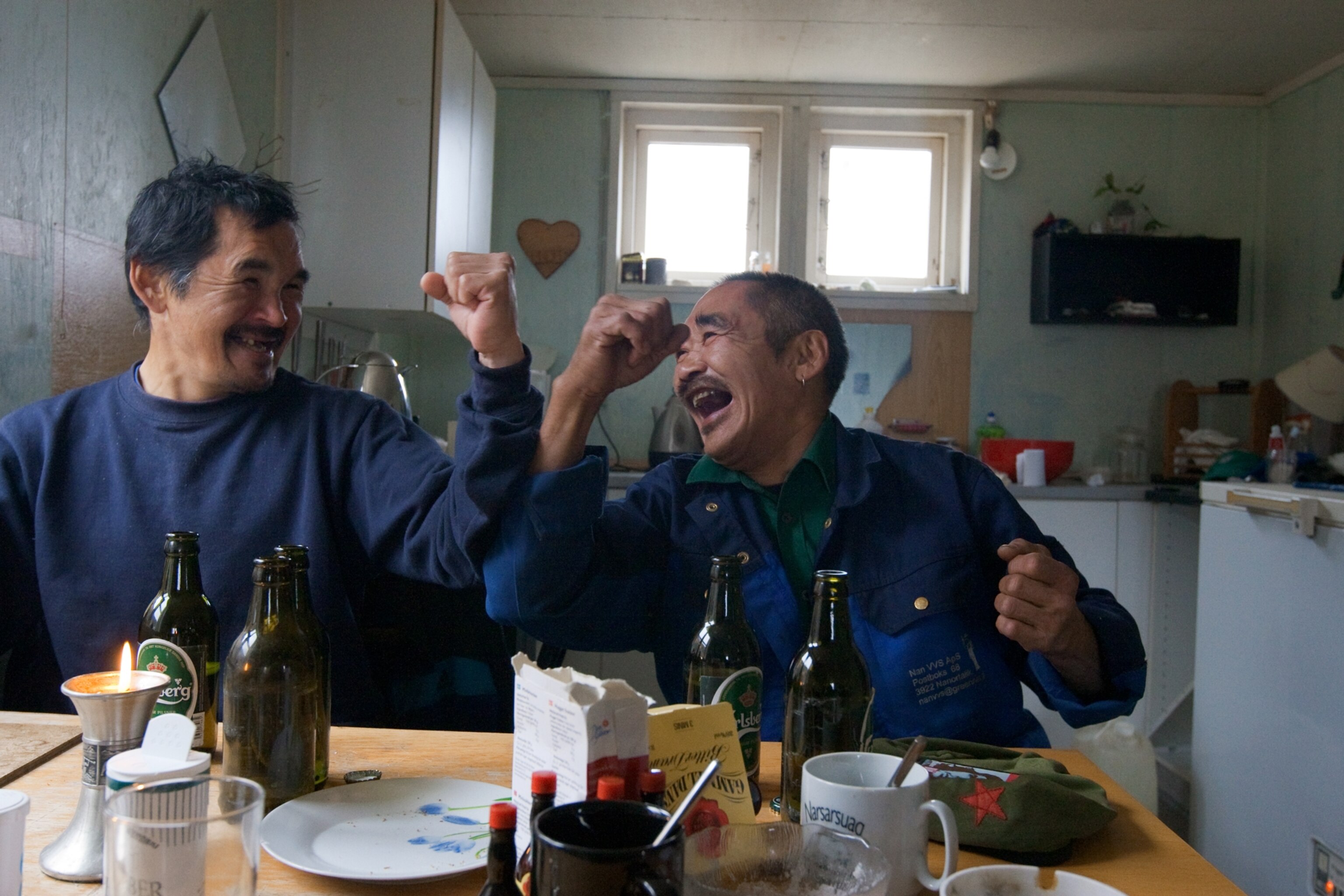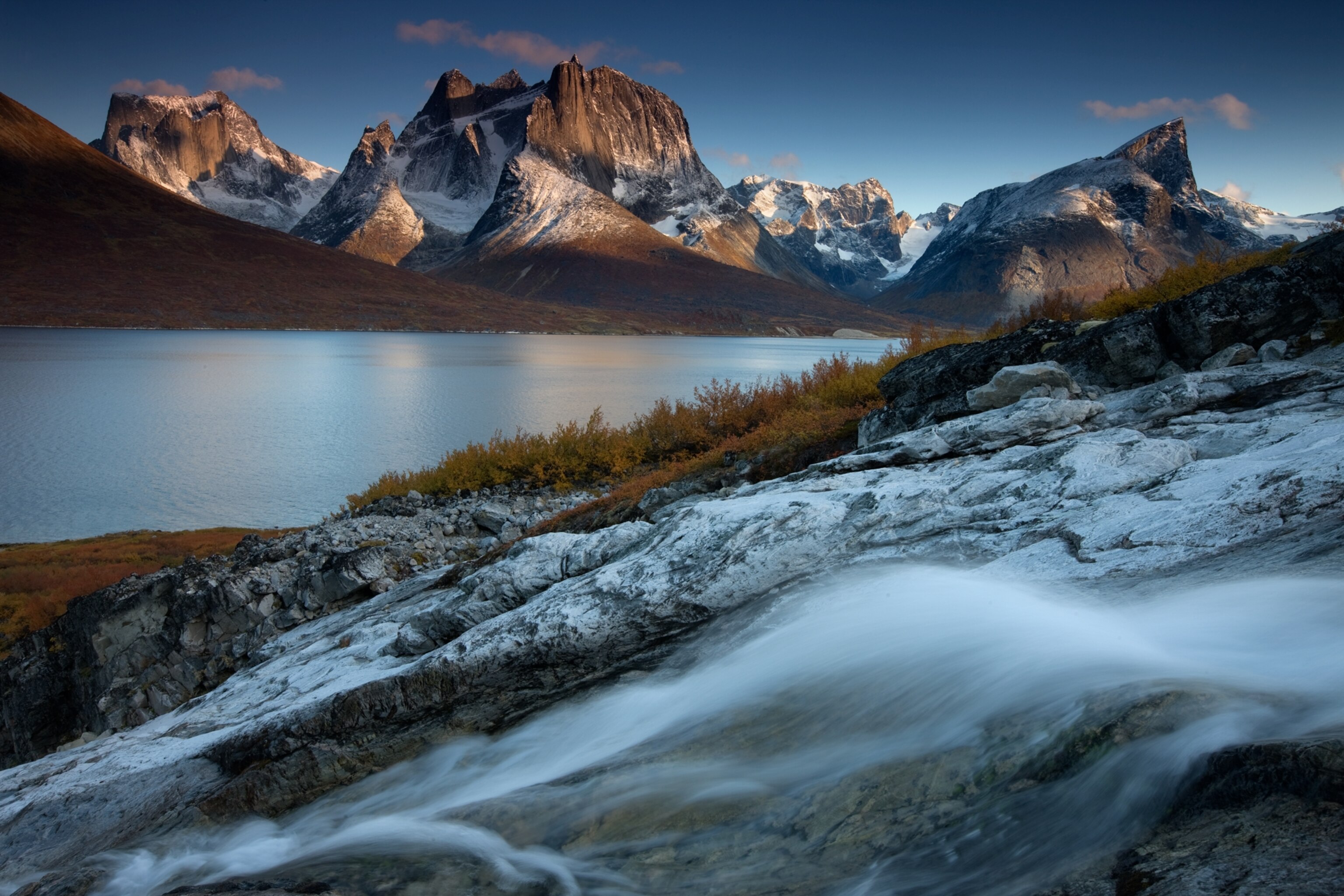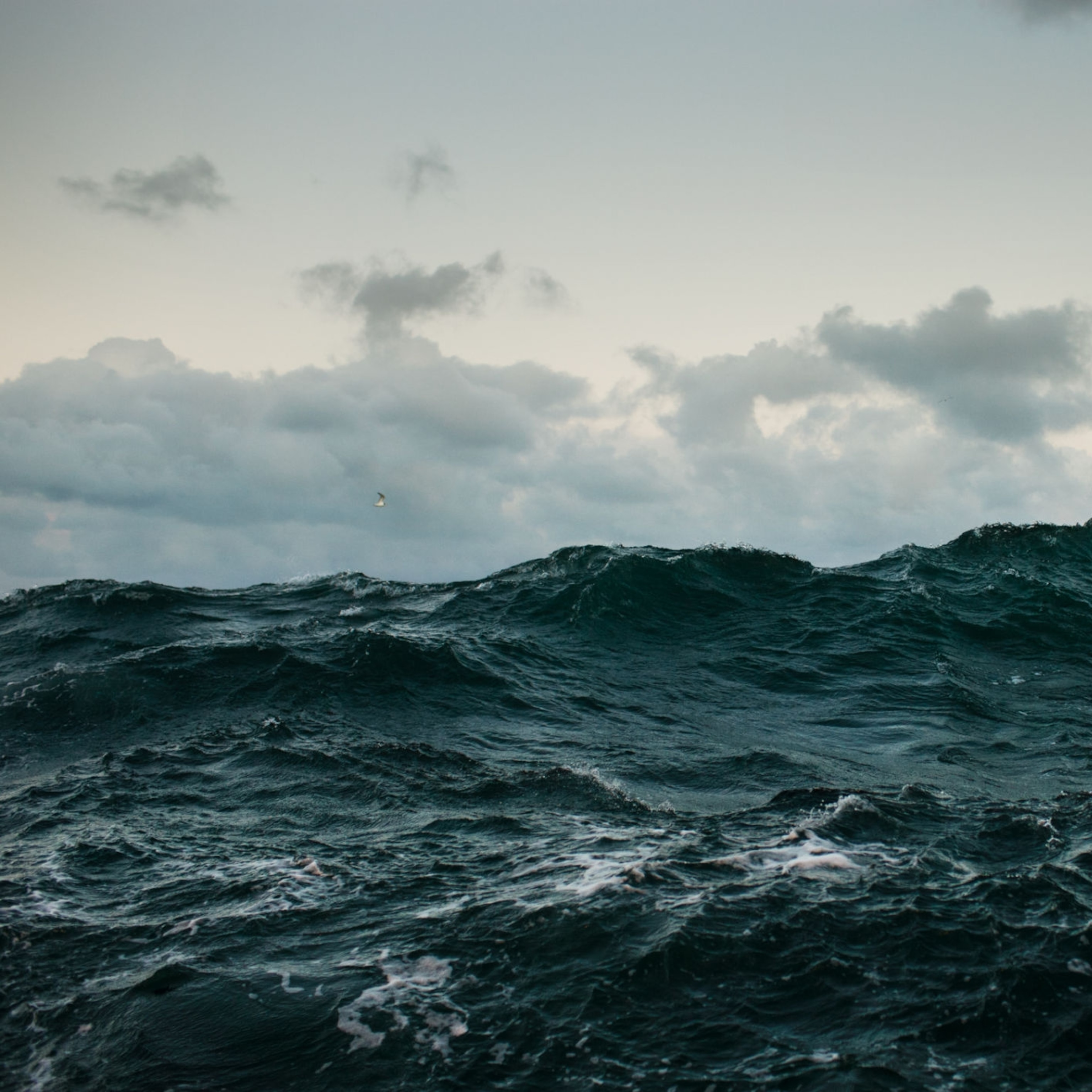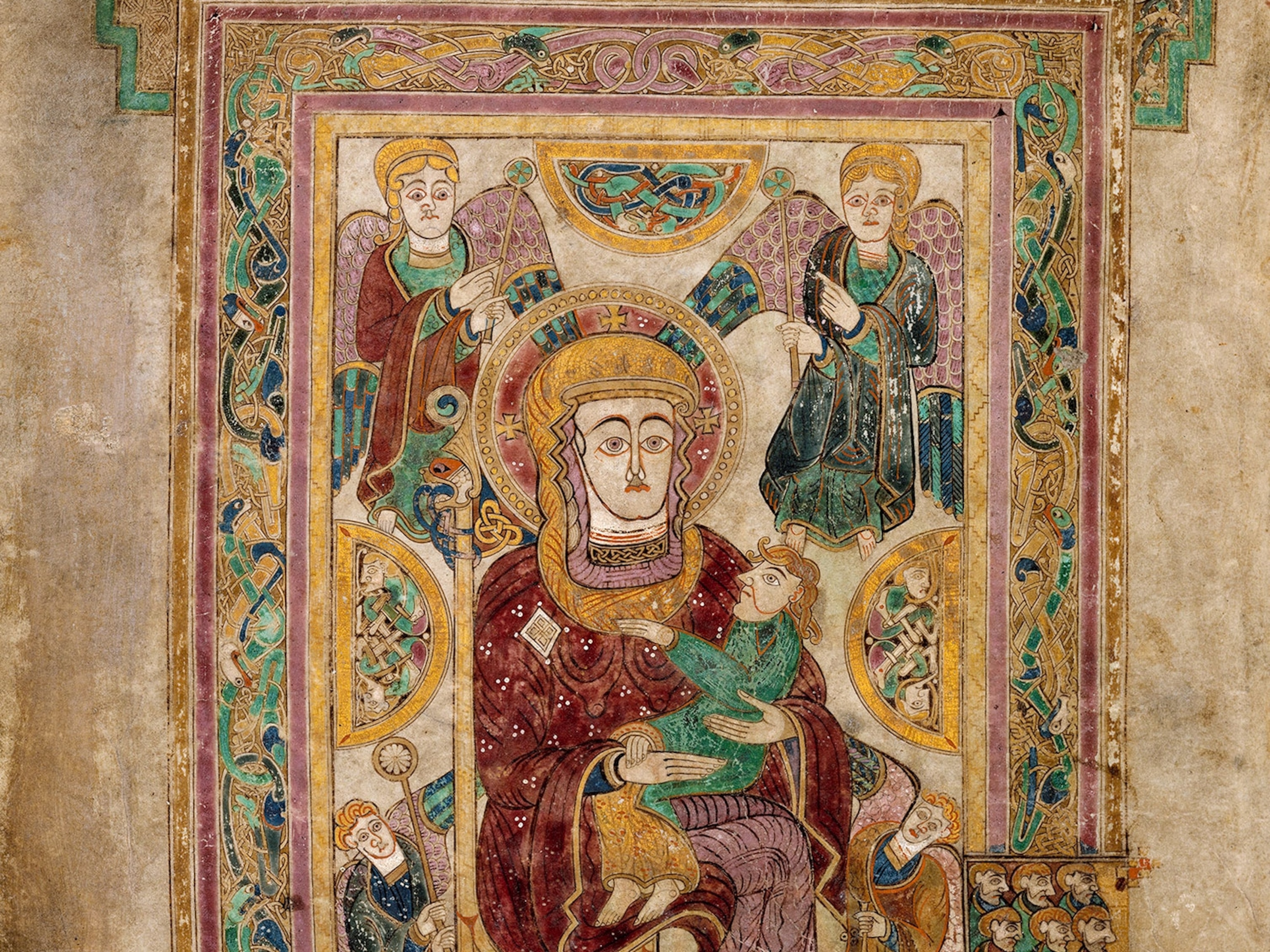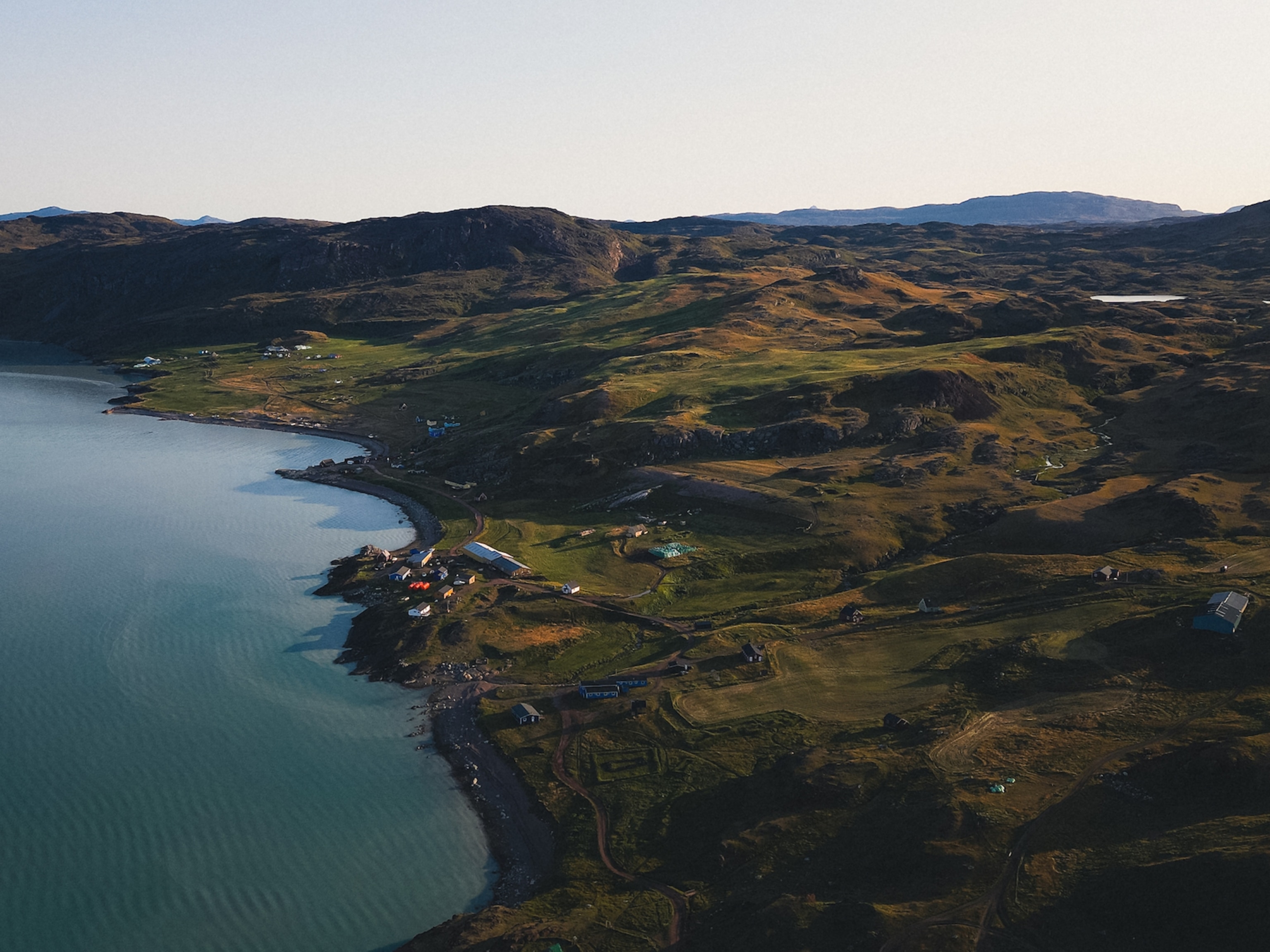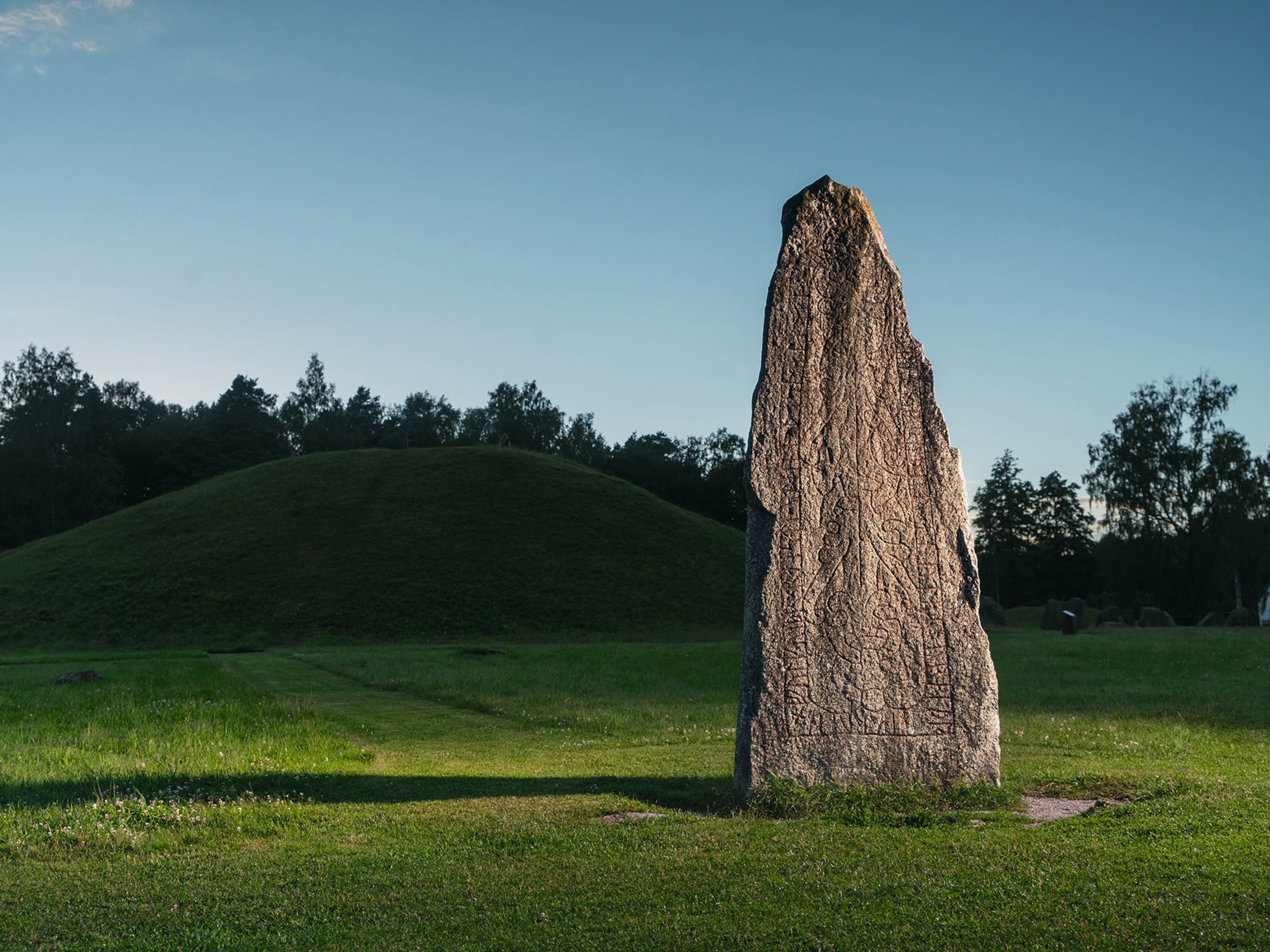Viking Weather
As Greenland returns to the warm climate that allowed Vikings to colonize it in the Middle Ages, its isolated and dependent people dream of greener fields and pastures—and also of oil from ice-free waters.
A little north and west of Greenland's stormy southern tip, on a steep hillside above an iceberg-clotted fjord first explored by Erik the Red more than a thousand years ago, sprout some horticultural anomalies: a trim lawn of Kentucky bluegrass, some rhubarb, and a few spruce, poplar, fir, and willow trees. They're in the town of Qaqortoq, 60° 43' north latitude, in Kenneth Høegh's backyard, about 400 miles south of the Arctic Circle.
"We had frost last night," Høegh says as we walk around his yard on a warm July morning, examining his plants while mosquitoes examine us. Qaqortoq's harbor glitters sapphire blue below us in the bright sun. A small iceberg—about the size of a city bus—has drifted within a few feet of the town's dock. Brightly painted clapboard homes, built with wood imported from Europe, freckle the nearly bare granite hills that rise like an amphitheater over the harbor.
Høegh, a powerfully built man with reddish blond hair and a trim beard—he could easily be cast as a Viking—is an agronomist and former chief adviser to Greenland's agriculture ministry. His family has lived in Qaqortoq for more than 200 years. Pausing near the edge of the yard, Høegh kneels and peers under a white plastic sheet that protects some turnips he planted last month.
"Wooo! This is quite incredible!" he says with a broad smile. The turnips' leaves look healthy and green. "I haven't looked at them for three or four weeks; I didn't water the garden at all this year. Just rainfall and melting snow. This is amazing. We can harvest them right now, no problem."
It's a small thing, the early ripening of turnips on a summer morning—but in a country where some 80 percent of the land lies buried beneath an ice sheet up to two miles thick and where some people have never touched a tree, it stands for a large thing. Greenland is warming twice as fast as most of the world. Satellite measurements show that its vast ice sheet, which holds nearly 7 percent of the world's fresh water, is shrinking by about 50 cubic miles each year. The melting ice accelerates the warming—newly exposed ocean and land absorb sunlight that the ice used to reflect into space. If all of Greenland's ice melts in the centuries ahead, sea level will rise by 24 feet, inundating coastlines around the planet.
Yet in Greenland itself, apprehension about climate change is often overshadowed by great expectations. For now this self-governing dependency of Denmark still leans heavily on its former colonial ruler. Denmark pumps $620 million into Greenland's anemic economy every year—more than $11,000 for each Greenlander. But the Arctic meltdown has already started to open up access to oil, gas, and mineral resources that could give Greenland the financial and political independence its people crave. Greenland's coastal waters are estimated to hold half as much oil as the North Sea's fields. Warmer temperatures would also mean a longer growing season for Greenland's 50 or so farms and perhaps reduce the country's utter reliance on imported food. At times these days it feels as if the whole country is holding its breath—waiting to see whether the "greening of Greenland," so regularly announced in the international press, is actually going to happen.
Greenland's first experience of hype happened a millennium ago when Erik the Red arrived from Iceland with a small party of Norsemen, aka Vikings. Erik was on the lam (from the Old Norse word lemja) for killing a man who had refused to return some borrowed bedsteads. In 982 he landed along a fjord near Qaqortoq, and then, despite the bedsteads incident, he returned to Iceland to spread word about the country he had found, which, according to theSaga of Erik the Red, "he called Greenland, as he said people would be attracted there if it had a favorable name."
Erik's bald-faced marketing worked. Some 4,000 Norse eventually settled in Greenland. The Vikings, notwithstanding their reputation for ferocity, were essentially farmers who did a bit of pillaging, plundering, and New World discovering on the side. Along the sheltered fjords of southern and western Greenland, they raised sheep and some cattle, which is what farmers in Greenland do today along the very same fjords. They built churches and hundreds of farms; they traded sealskins and walrus ivory for timber and iron from Europe. Erik's son Leif set out from a farm about 35 miles northeast of Qaqortoq and discovered North America sometime around 1000. In Greenland the Norse settlements held on for more than four centuries. Then, abruptly, they vanished.
The demise of those tough, seafaring farmers offers an unsettling example of the threats climate change poses to even the most resourceful cultures. The Vikings settled Greenland during a period of exceptional warmth, the same warm period that saw expanded agriculture and the construction of great cathedrals in Europe. By 1300, though, Greenland became much colder, and living there became ever more challenging. The Inuit, who had arrived from northern Canada in the meantime, pushing south along the west coast of Greenland as the Vikings pushed north, fared much better. (Modern Greenlanders are mostly descended from them and from Danish missionaries and colonists who arrived in the 18th century.) The Inuit brought with them dogsleds, kayaks, and other essential tools for hunting and fishing in the Arctic. Some researchers have argued that the Norse settlers failed because they remained fatally attached to their old Scandinavian ways, relying heavily on imported farm animals instead of exploiting local resources.
But more recent archaeological evidence suggests the Norse too were well adapted to their new home. Thomas McGovern, an anthropologist at Hunter College in Manhattan, says the Norse organized annual communal hunts for harbor seals, especially once the climate cooled and domestic livestock began to die. Unfortunately, harbor seals also succumbed. "Adult harbor seals can survive cold summers, but their pups can't," says McGovern. The Norse may have been forced to extend their hunts farther offshore in search of other seal species, in waters that were becoming more stormy.
"We now think the Norse had a very refined social system that required lots of community labor, but there was a major vulnerability—they had to have most of their adults out there trying to get the seals," says McGovern. "A trigger for the end of the Norse in Greenland could have been catastrophic loss of life from one bad storm." The Inuit would have been less vulnerable because they tended to hunt in small groups. "It's a much more complicated story than we thought," McGovern says. "The old story was just, the silly Vikings come north, screw up, and die. But the new story actually is a bit scarier, because they look pretty well adapted, well organized, doing a lot of things right—and they die anyway."
The last historically documented event of Norse life in Greenland was not a perfect storm, though, nor a famine nor an exodus to Europe. It was a wedding held at a church near the head of Hvalsey fjord, about ten miles northeast of Qaqortoq. Much of the church still stands on a grassy slope beneath a towering granite peak.
On a cool morning last summer a strand of fog lingered high up on the peak's eastern face like a gossamer pennant. Wild thyme with delicate, purple-red flowers spread low across the ground in front of the 800-year-old church, now roofed only by sky. All four of the three-foot-thick, stone-slab walls remain intact—the eastern wall is about 18 feet tall. They were evidently built by people who intended to stay here a while. Within the walls, grass and sheep droppings cover the uneven ground where, on September 14, 1408, Thorstein Olafsson married Sigrid Bjørnsdottir. A letter sent from Greenland to Iceland in 1424 mentions the wedding, perhaps as part of an inheritance dispute, but provides no news of strife, disease, or any inkling of impending disaster. Nothing more was ever heard from the Norse settlements.
Greenlanders today, all 56,000 of them, still live on the rocky fringes between ice and sea, most in a handful of towns along the west coast. Glaciers and a coastline deeply indented by fjords make it impossible to build roads between the towns; everyone travels by boat, helicopter, plane, or, in the winter, dogsled. More than a quarter of all Greenlanders, some 15,500, live in Nuuk, Greenland's capital, about 300 miles north of Qaqortoq as the narwhal swims.
Take one part quaint Greenlandic town, complete with fjord and exhilarating mountainous backdrop, mix with maybe four parts grim Soviet-bloc-style apartments, add two traffic lights, daily traffic jams, and a nine-hole golf course, and you've got Nuuk. The sprawling, run-down apartment blocks are a legacy of a forced modernization program from the 1950s and 1960s, when the Danish government moved people from small traditional communities into a few large towns. The intent was to improve access to schools and health care, reduce costs, and provide employees for processing plants in the cod-fishing industry, which boomed in the early 1960s but has since collapsed. Whatever benefits the policy brought, it bred a host of social problems—alcoholism, fractured families, suicide—that still plague Greenland.
But this morning, on the first day of summer 2009, the mood in Nuuk is jubilant: Greenland is celebrating the start of a new era. In November 2008 its citizens voted overwhelmingly for increased independence from Denmark, which has ruled Greenland in some form since 1721. The change is to become official this morning in a ceremony at Nuuk's harbor, the heart of the old colonial town. Queen Margrethe II of Denmark will formally acknowledge the new relationship between her country and Kalaallit Nunaat, as the locals call their homeland.
Per Rosing, a slender 58-year-old Inuit man with a gentle manner and a graying black ponytail, conducts the Greenland National Choir. "I'm just happy, totally happy," he says, putting a hand over his heart as we walk with a large crowd toward the harbor, down streets still wet from last night's freezing rain and snow. People are streaming out of Block P, Nuuk's biggest apartment building, which alone houses about one percent of Greenland's population. Its windowless, concrete end has become a frame for a defiantly optimistic work of art: a four-story-tall, white-and-red Greenlandic flag. A local artist sewed the flag with the help of schoolchildren from hundreds of articles of clothing.
By 7:30 people are packed shoulder to shoulder on the dock. Others perch on the roofs of old wooden homes around the harbor; a few watch from kayaks, paddling just enough to stay put in calm, metallic-looking water. The ceremony begins with the choir singing Greenland's national anthem, "Nunarput Utoqqarsuanngoravit—You, Our Ancient Land." Rosing turns to the crowd and gestures for everyone to join in. As of today, Kalaallisut, an Inuit dialect, is the official Greenlandic language, supplanting Danish.
Then, shortly after eight o'clock, the Danish queen, wearing the traditional Inuit garb of a married woman—red, thigh-high, sealskin boots, or kamiks, a beaded shawl, and seal-fur shorts—presents the new self-government charter to Josef Tuusi Motzfeldt, the speaker of Greenland's Parliament. The crowd cheers, and a cannon fires on a hill above the harbor, sending a pressure wave through us like a shared infusion of adrenaline.
Under the new charter, Denmark still manages Greenland's foreign policy; the annual subsidy continues as well. But Greenland now exerts greater control over its own domestic affairs—and in particular, over its vast mineral resources. Without them, there's no chance that Greenland could ever become economically independent. Right now fishing accounts for more than 80 percent of Greenland's export income; shrimp and halibut are the mainstays. While halibut stocks are holding steady, shrimp populations have dropped. Royal Greenland, the state-owned fishing company, is bleeding money.
The reasons for the decline of the shrimp—known here as "pink gold"—are unclear. Søren Rysgaard, director of the Greenland Climate Research Center in Nuuk, says that Greenland's climate, besides getting warmer, is becoming more unpredictable. Rising sea temperatures may have disrupted the timing between the hatching of shrimp larvae and the blooms of phytoplankton the larvae feed on; no one really knows. Fishermen hope cod will return as waters warm. But after a small uptick a few years ago, cod numbers have fallen again.
"The traditional way of life in Greenland was based on stability," says Rysgaard. Apart from southern Greenland, which has always been swept by Atlantic storms, the climate, although formidably cold, seldom surprised. The huge ice sheet, with its attendant mass of cold, dense air, enforced stability over most of the country. "In the winter you could hunt or fish with your sled dogs on the sea ice. In the summer you could hunt from a kayak. What's happening now is that the instability typical of southern Greenland is moving north."
Johannes Mathæussen, a 47-year-old Inuit halibut fisherman, has seen those changes firsthand. Mathæussen lives in Ilulissat (Greenlandic for "icebergs"), a town of 4,500 people and almost that many sled dogs located 185 miles north of the Arctic Circle. On an overcast day in late June we set out from Ilulissat's harbor, motoring past a big shrimp trawler in Mathæussen's 15-foot-long open boat, a typical craft for halibut fishermen here. Summer fishing is still good for them, but winter is becoming a problem.
"Twenty years ago, in the winter, you could drive a car over the ice to Disko Island," Mathæussen says, pointing to a large island about 30 miles off the coast. "For 10 of the last 12 years, the bay has not frozen over in the winter." When the bay used to freeze, Mathæussen and other fishermen would rig their dogsleds and go ice fishing ten miles up the fjord. "I would spend a day and a night and bring back 200 or 500 pounds of halibut on my sled. Now winter fishing in the fjord is dangerous with a heavy load; the ice is too thin."
Mathæussen steers his boat through a broken canyon of ice that is drifting imperceptibly out to sea. The largest bergs rise 200 feet above us with keels scraping the bottom 600 feet down. Each one has its own topography of hills, cliffs, caves, and arroyos of smooth white flanks polished by meltwater streams. All this ice comes from Jakobshavn Isbræ, aka Sermeq Kujalleq, the "southern glacier," which drains 7 percent of Greenland's ice sheet and launches more icebergs than any other Northern Hemisphere glacier. (The iceberg that sank theTitanic probably calved here.) In the past decade Sermeq Kujalleq has retreated almost ten miles up the fjord. It is Greenland's biggest tourist draw—19,375 people came to see global warming in action here in 2008. Tourism remains a distant second to fishing, though; the season is short, accommodations are limited, and travel is expensive.
The foundation of Greenland's future economy lies out beyond Disko Island, just over the horizon from Mathæussen's spectacular fishing ground: That's where the oil is. The sea off the central west coast now typically remains ice free for nearly half the year, a month longer than 25 years ago. With the greater ease of working in Greenland's waters, ExxonMobil, Chevron, and other oil companies have acquired exploration licenses. Cairn Energy, a Scottish company, plans to drill its first exploration wells this year.
"We've issued 13 licenses covering 130,000 square kilometers off the west coast, roughly three times the size of mainland Denmark," says Jørn Skov Nielsen, director of Greenland's Bureau of Minerals and Petroleum. We're at a bustling trade convention in a conference center in Nuuk on a rainy Saturday afternoon. The smell of oil wafts from a rock sample—a chunk of basalt the size and shape of half a bowling ball—that is displayed on a nearby table. "Production could be possible in ten years if we're lucky," Nielsen says. "We have some very impressive estimates for northwest and northeast Greenland—50 billion barrels of oil and gas." With oil prices now topping $80 a barrel, those reserves would be worth more than four trillion dollars, a windfall that could fund the country's independence.
To some Greenlanders it would be a Faustian bargain. Sofie Petersen, the Lutheran bishop, has an office overlooking the harbor in one of Nuuk's few surviving old wooden homes. Just up the hill stands a statue of Hans Egede, a quixotic Lutheran missionary who came here in 1721 looking for survivors of the lost Norse settlements. He found no Norsemen but founded Nuuk, or Godthåb, as the Danes called it, and set in motion the Danish colonization of Greenland and its conversion to Christianity. Like nearly all Greenlanders, Petersen has a Danish surname, but she is Inuit.
"I think oil will damage our way of living," she says. "Of course everyone needs money, but should we sell our souls? What will happen if we are millionaires, every one of us, and we can't deliver Greenland as we know it to our grandchildren? I would rather have little money and give the land to our grandchildren instead."
"It's a big dilemma to deal with the oil issue, since the Arctic people are the ones most exposed to climate change," says Kuupik Kleist, Greenland's popular new prime minister. Sometimes called Greenland's Leonard Cohen—he has recorded a few CDs—Kleist is a broadly built, owlish man of 52 with a husky, sonorous voice. The irony in his country becoming a major producer of the very stuff that is helping to melt its ice sheet is not lost on him.
"We need a stronger economy," Kleist says, "and we have to utilize the opportunities that oil could bring to us. Environmentalists around the world advise us not to exploit the oil reserves. But we are not in the situation where we can replace the declining income from our fisheries, and we don't have any other resources for the time being that hold as much potential as oil."
Actually there is one other resource with enormous potential, but it is equally fraught. Greenland Minerals and Energy Ltd., an Australian company, has discovered what may be the world's largest deposit of rare earth metals on a plateau above the town of Narsaq in southern Greenland. The rare earths are crucial in a wide variety of green technologies—hybrid-car batteries, wind turbines, and compact fluorescent lightbulbs—and China now controls more than 95 percent of the world's supply.
The development of the deposit at Narsaq would fundamentally shift global markets and transform Greenland's economy. John Mair, general manager of Greenland Minerals and Energy, says that Narsaq's reserves could sustain a large-scale mining operation for well over 50 years, employing hundreds in a town that has been devastated by the collapse of cod fishing. His company has dozens of employees prospecting the site right now. But there is a major obstacle to developing it: The ore is also laced with uranium, and Greenland's government has a complete ban on uranium mining. "We haven't changed those regulations and are not planning to," Kleist says. There is no easy path, it seems, to a greener Greenland, in any sense of the word.
Greenlanders jokingly call the area around Narsaq and Qaqortoq, Sineriak Banaaneqarfik, the Banana Coast. Today the grandchildren of Inuit hunters till fields there, along fjords where Vikings once farmed. If Greenland is greening anywhere, it is here. But as soon as I arrive, the agronomist Kenneth Høegh cautions me to forget what I've read about Greenland's sudden cornucopia. "Arctic Harvest," read one headline; "In Greenland, Potatoes Thrive," read another. Potatoes do grow in Greenland these days. But not so very many just yet.
On a gorgeous July morning Høegh and I are cruising at about 25 knots up the fjord settled by Erik the Red a millennium ago. Our destination is Ipiutaq, population three. Kalista Poulsen is waiting for us on a rocky outcrop below his farm on the northern shore of the fjord. Even in faded gray overalls, Poulsen looks more like a scholar than a farmer: He's slender, wears glasses, and speaks English with what sounds, strangely enough, like a French accent. His great-great-grandfather was an angakkoq—a shaman—one of the last in Greenland, who had killed men in feuds before converting to Christianity after having a vision of Jesus.
We walk through Poulsen's lush fields of timothy and ryegrass. Compared with the fjord's sheer gray walls, the fodder crops look almost fluorescent. In September Poulsen will acquire his first sheep, which is what nearly all of Greenland's farmers raise, mostly for meat. He bought the farm in 2005, as the outside world was first hearing talk of a gentler, warmer Greenland.
From where Poulsen stands, the promise seems remote. "This is my war zone," he says, as we trudge across muddy, boulder-strewn ground that he's clearing for cultivation with a backhoe and a tractor with big tillers he had delivered on old military landing craft. When I ask Poulsen if he thinks global warming will make life easier for him or his child, his expression becomes almost pained. He looks at me appraisingly as he lights a cigarette, which momentarily disperses a cloud of mosquitoes.
"Last year we almost had a catastrophe," he says. "It was so dry the harvest was only half of normal. I don't think we can count on normal weather. If it's getting warmer, we'll have to water more, invest in a watering system. In the winter we don't have normal snow; it rains, and then it freezes. That's not good for the grass. It's just exposed in the cold."
Over lunch in Poulsen's white wood-frame home, the mystery of his French accent is solved: Agathe Devisme, his companion, is French. Savoring the fusion meal she has prepared—shrimp and catfish au gratin, mattak, or raw whale skin, and apple cake flavored with wild angelica—I think back to the more rustic dinner I'd enjoyed a few nights earlier in Qaqortoq, at an annual gala attended by nearly every farming family on the Banana Coast. After dinner a white-haired Inuit man had begun playing an accordion, and everyone in the hall, some 450 people, had linked arms, swaying side to side as they sang a traditional Greenlandic paean:
Summer, summer, how wonderful
How incredibly good.
The frost is gone,
The frost is gone …
Leaving the Poulsens, Høegh and I run back down the fjord with the føn—the wind off the ice sheet—at our stern. Høegh would be happy, he had said earlier, if Greenland's farms were to get to the point where they grow most of their own winter fodder for their sheep and cattle; many farms, far from feeding their countrymen, now import more than half their fodder from Europe. In Høegh's house that evening we stand looking out the window at his garden. The føn has become fierce. Horizontal sheets of rain flatten his rhubarb and his turnips; his trees bend like supplicants before implacable old gods. "Damn!" Høegh says quietly. "The weather's tough here. It will always be tough."

